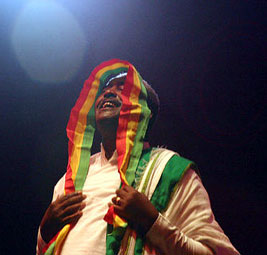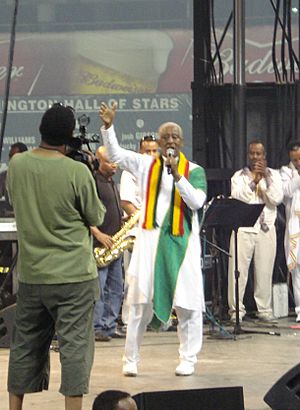Mahmoud Ahmed facts for kids
Quick facts for kids
Mahmoud Ahmed
ማሕሙድ አሕመድ |
|
|---|---|

Mahmoud Ahmed performing in 2005
|
|
| Background information | |
| Born | 8 May 1941 Addis Ababa, Ethiopia |
| Origin | Gurage, Ethiopia |
| Died | Error: Need valid death date (first date): year, month, day |
| Genres |
|
| Instruments | Vocals |
| Years active | 1970s–present |
| Labels |
|
Mahmoud Ahmed (born May 8, 1941) is a famous singer from Ethiopia. His music became very popular in Ethiopia during the 1970s. Later, Ethiopians living in other countries also loved his songs. He then became known around the world, especially among fans of African music in Europe and the Americas.
Contents
Biography
Early Life and Start in Music
Mahmoud Ahmed was born in Addis Ababa, Ethiopia. From a young age, he loved the music he heard on the radio. He did not do well in school. He first worked as a shoeshiner. Then, he became a handyperson at the Arizona Club. This club was a place where the Emperor's special band, the Imperial Bodyguard Band, would hang out.
One night in 1962, the band's singer did not show up. Mahmoud asked if he could sing a few songs. Everyone was impressed! He soon became a regular singer with the band. He sang with them until 1974.
Recording Music and Gaining Fame
Mahmoud released his first songs in 1971. These were "Nafqot New Yegodagn" and "Yasdestal." He continued to record with different bands. He worked with record labels like Amha and Kaifa throughout the 1970s.
During this time, there were big changes in Ethiopia. The government changed, and musical performances were paused. Mahmoud kept making hit songs and albums. He worked with bands like the Dahlak Band and the Ibex Band. He also started releasing his own solo albums. On these, he played instruments like the krar, guitar, or mandolin.
By 1978, new rules made it hard to release music on vinyl records. So, Mahmoud started releasing his music on cassettes instead. In the 1980s, he even opened his own music store in Addis Ababa. He continued his singing career.
Many Ethiopians were living in other countries. Mahmoud was one of the first modern Ethiopian musicians to tour the United States. This happened in 1980 and 1981. He toured with the Walias Band and other artists. Mahmoud then started releasing music with the Roha Band. He became very popular with Ethiopian communities living abroad.
International Recognition
In 1986, Mahmoud's music reached more people in Western countries. A Belgian music company, Crammed Discs, released a collection called Ere Mela Mela. This album included songs Mahmoud had recorded earlier with the Ibex Band. At the time, Ethiopia was in the news for difficult reasons. The happy sound of Mahmoud's music was a nice contrast. It became very popular in the growing world music scene.
Mahmoud became even more famous around the world in the late 1990s. This was when Buda Musique started the Éthiopiques series of CDs. This led to new recordings and tours in Europe and the United States. He performed with groups like Boston's Either/Orchestra and Badume Band. Mahmoud still lives in Addis Ababa. He also works with groups that help people. He continues to tour internationally, performing for both world music fans and Ethiopians living abroad.
Later Works and Style
In 1996, Mahmoud released Tizita, a CD and cassette of his best songs. He released a second volume about two years later. These albums featured members of the Roha Band and other musicians. While Ere Mela Mela made him famous, Mahmoud is also known for his Tizita music. This style is slow and groovy. It makes people think about the past. The word Tizita means "memories." It is similar to the idea of saudade in Portuguese music. Many songs on his 1997 album Soul of Addis talk about love, loneliness, and longing.
Mahmoud is also a visual artist. He creates drawings and illustrations. He uses a pencil to draw different themes, depending on his mood. He was once asked to show his artwork in Addis Ababa, but he said no.
In 2000, Mahmoud released Hulum Yisma. This album had new songs and lyrics. Dawit Yifru, a member of the Roha Band, arranged most of the songs. Mahmoud also worked with a newer, younger group called the 3M Band.
Members of the 3M Band later worked with Mahmoud again. In 2003, they recorded Yitbarek. This album was a collection of traditional Ethiopian wedding songs. It also included some of Mahmoud’s older songs. Songs like "Musheraye" and "Hay Loga" are well-known traditional tunes from this album.
Even though he has not released many new recordings recently, Mahmoud's career is still active. He has recorded with other famous artists. These include Tsehay Yohannes, Gossaye Tesfaye, and Tommy T.
In 2007, Mahmoud won a BBC World Music Award. In 2015, he appeared on an episode of Anthony Bourdain's Parts Unknown. This episode explored Ethiopia.
Discography
- Almaz with Ibex Band (1973 LP; reissued in 1999 as Éthiopiques Volume 6)
- Alemye (1974 LP, reissued in 2005 as Éthiopiques Volume 19)
- Ere Mela Mela (1975 LP, rereleased in 1986, and reissued in 2000 as Ethiopiques Volume 7)
- Soul of Addis (1997)
- Slow Collections (1998)
- Live in Paris (1998)
- Yitbarek (2003)
- Tizita Vol. 1 (The Best of...) (2003)
- Tizita Vol. 2 (The Best of...) (2003)
- The Rough Guide to the Music of Ethiopia (2004)
- Ethiogroove: Mahmoud Ahmed & Either/Orchestra, with Tsedenia G. Markos (2007 DVD)
- Éthiopiques Live: Mahmoud Ahmed, Alemayehu Eshete & Badume's Band (2009 DVD)
- Éthiopiques 26: Mahmoud Ahmed & Imperial Bodyguard Band, 1972–1974 (collects music from singles)
- The Rough Guide to the Music of Ethiopia (2012)


